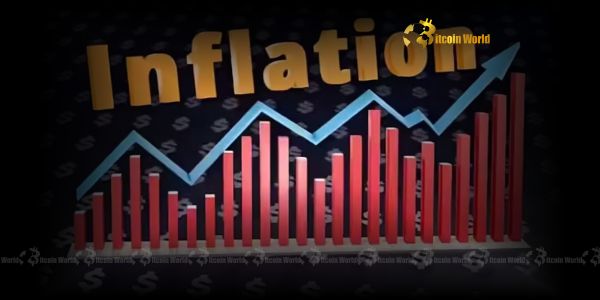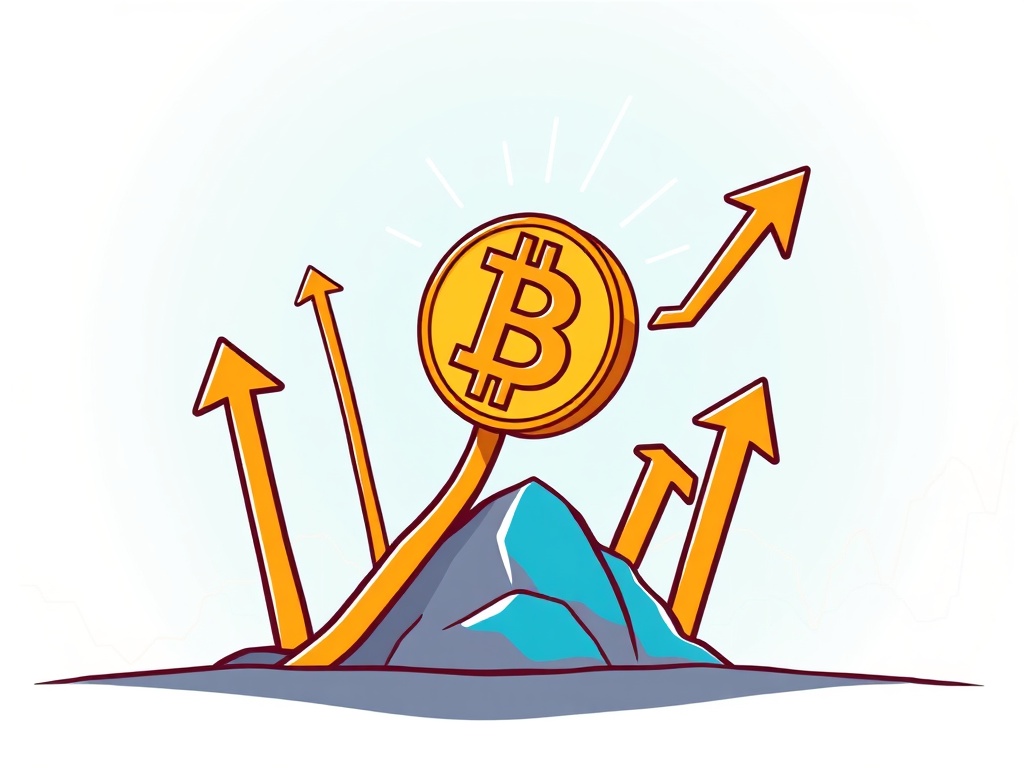BitcoinWorld

Eurozone Inflation Unveils Urgent Economic Outlook: A 2.0% CPI Deep Dive
The world of finance is a tapestry woven with interconnected threads, where macroeconomic shifts in one region can send ripples across global markets, including the often-volatile cryptocurrency landscape. Recently, a key development emerged from the heart of Europe that warrants close attention: Eurozone inflation experienced a slight climb in June, with the annual Consumer Price Index (CPI) reaching 2.0%. While seemingly a modest figure, this rise carries significant implications for traditional investors, policymakers, and indeed, those navigating the digital asset space. Understanding these shifts is crucial for anticipating market movements and making informed decisions in an increasingly globalized financial ecosystem.
Understanding the Latest Eurozone Inflation Figures: What Does 2.0% Mean?
The latest data from Eurostat indicates that Eurozone inflation, as measured by the harmonized Consumer Price Index (HICP), reached an annual rate of 2.0% in June. This figure marks a slight increase from previous months and brings the inflation rate precisely in line with the European Central Bank’s (ECB) target. But what exactly does this 2.0% figure represent, and why is it a significant benchmark for the Eurozone economy?
- Defining CPI: The Consumer Price Index (CPI), or HICP in the Eurozone’s case, is a measure that examines the weighted average of prices of a basket of consumer goods and services, such as transportation, food, and medical care. It is calculated by taking price changes for each item in the predetermined basket of goods and averaging them. Changes in the CPI are used to assess price changes associated with the cost of living.
- The ECB’s Target: The European Central Bank aims for an inflation rate of 2.0% over the medium term. This target is considered optimal for maintaining price stability while allowing sufficient room for economic growth. An inflation rate too low can signal deflationary pressures, potentially leading to reduced spending and investment, while a rate too high erodes purchasing power.
- Components of the Rise: The slight climb in June was likely influenced by various factors. Often, energy prices play a significant role due to their volatility, but other components like services and non-energy industrial goods also contribute. Understanding which sectors are driving the increase provides insight into the underlying health and pressures within the economy. For instance, if services inflation is high, it suggests strong domestic demand, whereas energy price rises are often external shocks.
How Does a 2.0% Annual CPI Impact Everyday Life and Markets?
While 2.0% might seem like a small number, its implications for consumers, businesses, and financial markets are far-reaching. The annual CPI acts as a barometer for the cost of living and directly influences economic behavior. For instance, when prices rise, the purchasing power of money decreases, meaning your euro buys slightly less than it did a year ago.
Impact on Consumers:
- Purchasing Power: A 2.0% inflation rate means that on average, goods and services cost 2% more than they did last year. For households, this translates to a subtle erosion of savings if income growth doesn’t keep pace.
- Cost of Living: Everyday expenses, from groceries to utility bills, gradually increase. While a 2.0% rise might not feel drastic immediately, it compounds over time, affecting household budgets and financial planning.
Impact on Businesses:
- Input Costs: Businesses face higher costs for raw materials, energy, and labor. This can squeeze profit margins if they cannot pass these costs on to consumers.
- Pricing Strategies: Companies must carefully consider their pricing strategies. Raising prices too much can deter customers, while not raising them enough can impact profitability.
Impact on Financial Markets:
For investors, a 2.0% CPI reading signals stability but also prompts questions about future central bank actions. Bond yields, equity valuations, and currency exchange rates are all sensitive to inflation data. Higher inflation expectations can lead to higher bond yields as investors demand more compensation for the erosion of their money’s value. This, in turn, can affect borrowing costs across the economy.
The ECB’s Dilemma: Navigating Monetary Policy Amidst Rising Prices
The European Central Bank (ECB) finds itself in a delicate balancing act. Achieving its 2.0% inflation target is a success, but maintaining it requires careful calibration of monetary policy. The ECB’s primary mandate is price stability, but it also supports the general economic policies in the Union with a view to contributing to the achievement of the objectives of the Union, which include sustainable economic growth and high employment.
Historically, central banks use several tools to manage inflation:
- Interest Rates: Raising key interest rates makes borrowing more expensive, which can cool down economic activity and reduce inflationary pressures. Conversely, lowering rates stimulates borrowing and spending.
- Quantitative Easing (QE) / Tightening (QT): QE involves buying government bonds or other financial assets to inject liquidity into the financial system, while QT involves reducing the size of the central bank’s balance sheet, effectively withdrawing liquidity.
- Forward Guidance: Communicating future policy intentions to guide market expectations.
The challenge for the ECB is to assess whether the current inflation climb is transitory (due to temporary supply chain disruptions or energy price spikes) or more persistent (due to strong demand or wage growth). A misstep in monetary policy – tightening too aggressively could stifle economic recovery, while being too dovish could allow inflation to become entrenched – carries significant risks for the entire Eurozone.
How the Eurozone Economic Outlook Influences Global Markets and Crypto
The health of the Eurozone economy, as reflected in its economic outlook, has significant ripple effects far beyond its borders. As one of the world’s largest economic blocs, developments here can sway global investor sentiment, currency markets, and even the appetite for risk assets like cryptocurrencies.
Interconnectedness with Global Economy:
- Trade Flows: The Eurozone is a major trading partner for many countries. Its economic performance directly impacts global trade volumes and supply chains.
- Currency Markets: The Euro (EUR) is the second most traded currency globally. Its strength or weakness, often influenced by the economic outlook and interest rate differentials, affects international trade and investment. A stronger Euro makes Eurozone exports more expensive, while a weaker Euro makes them cheaper.
- Investor Confidence: A stable and growing Eurozone contributes to overall global investor confidence, encouraging investment in various asset classes worldwide. Conversely, economic instability can lead to risk aversion.
Implications for Cryptocurrency:
While often seen as a separate asset class, cryptocurrencies are not entirely immune to traditional macroeconomic forces. When major economies like the Eurozone show signs of inflation or economic uncertainty, it can influence:
- Risk Appetite: In times of economic stress or high inflation, investors may shift away from riskier assets, including cryptocurrencies, towards perceived safe havens. Conversely, a stable economic environment can foster greater risk-taking.
- Liquidity: Central bank policies, driven by the economic outlook, affect global liquidity. Tighter monetary conditions (e.g., higher interest rates) can reduce the amount of capital available for speculative investments, potentially impacting crypto valuations.
- Narratives: Persistent inflation in traditional fiat currencies can strengthen the narrative of Bitcoin as a hedge against inflation, potentially attracting new investors to the crypto space, though this is a complex and debated topic.
The Potential Impact on ECB Interest Rates and Beyond
The 2.0% CPI figure is a critical data point for the European Central Bank’s Governing Council as they deliberate on the future trajectory of ECB interest rates. Reaching the target might suggest less urgency for aggressive rate hikes, but sustained inflation pressures could change that.
What to Watch For:
- Forward Guidance: The ECB’s communication regarding its future policy intentions will be paramount. Any hints about potential rate hikes or adjustments to asset purchase programs will be closely scrutinized by markets.
- Economic Data Consistency: The ECB will look for consistency in inflation data, wage growth, and overall economic activity before making significant policy shifts. A one-off spike is less concerning than a trend.
- Global Context: Actions by other major central banks, particularly the US Federal Reserve, can also influence the ECB’s decisions, as coordinated or divergent policies can impact currency valuations and capital flows.
Consequences of Rate Changes:
Any adjustment to ECB interest rates would have widespread consequences:
- Borrowing Costs: Higher rates mean more expensive loans for businesses and consumers, affecting everything from mortgages to corporate investments. This can cool demand and inflation.
- Bond Yields: Government bond yields would likely rise, making it more expensive for Eurozone governments to borrow.
- Currency Valuation: Higher interest rates typically make a currency more attractive to foreign investors, potentially strengthening the Euro.
For the crypto market, higher traditional interest rates can make risk-free assets (like government bonds) more appealing, potentially drawing capital away from more speculative investments. Conversely, if inflation remains high and real returns on traditional assets are negative, it might push some investors towards crypto as an alternative.
Conclusion: Navigating the Nuances of Eurozone Inflation
The slight climb in Eurozone inflation to an annual CPI of 2.0% in June marks a significant moment, bringing the region’s price growth precisely in line with the European Central Bank’s long-term target. This development underscores the ongoing complexities faced by policymakers as they strive to maintain price stability while fostering sustainable economic growth. The ECB’s careful navigation of its monetary policy will be crucial in determining the future path of ECB interest rates and shaping the broader economic outlook for the Eurozone.
For investors, including those in the cryptocurrency space, understanding these macroeconomic currents is not just an academic exercise; it’s a vital part of risk assessment and opportunity identification. While traditional finance and digital assets operate on different rails, they are undeniably connected by the overarching forces of global liquidity, investor sentiment, and central bank actions. The Eurozone’s inflation story is a compelling chapter in the global economic narrative, demanding continued attention and careful analysis.
To learn more about the latest Forex market trends, explore our article on key developments shaping interest rates liquidity.
This post Eurozone Inflation Unveils Urgent Economic Outlook: A 2.0% CPI Deep Dive first appeared on BitcoinWorld and is written by Editorial Team





